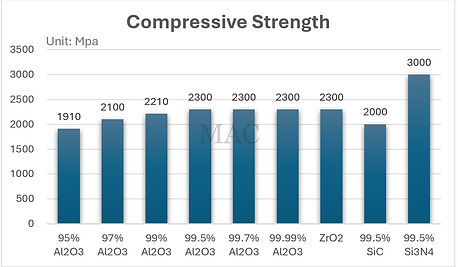
Ceramic Materials
MAC products include a wide array of technical and advanced ceramics such as Alumina, Zirconia, Silicon Carbide, and Silicon Nitride. These materials have been meticulously engineered to enhance and extend the performance of your products, processes, or systems. Our ceramics offer a multitude of benefits, including high temperature stability, hard and wear-resistant surfaces, improved stiffness-to-weight ratios, anti-corrosive barriers, and low thermal expansion rates. With MAC' technical ceramics, you can gain significant performance and cost advantages, tailored to meet your specific needs.

Alumina Ceramic
-
Alumina Ceramics is the most widely used fine ceramics material. This material has superb material characteristics such as high electrical insulation, high mechanical strength, high wear and chemical resistance.Common alumina ceramics are divided into 99 porcelain, 95 porcelain, 93 porcelain, 92 porcelain, 85 porcelain and other varieties according to the ₃ content of Al₂O₃

Yttria Stabilized Zirconia
-
YSZ ceramics are widely used to handle corrosive chemicals and molten metal. It also provide low contamination due to the wear resistance and corrosion resistance.
-
Applications of Yttria Stabilized Zirconia (YSZ) parts
-
Used for grinding ceramics materials, magnetic materials and organic samples
-
Bearing and other wear resistance mechanical parts
-
Special pump parts

Magnesium/Ceriu Stabilized Zirconia
-
Zirconia ceramics, ZrO2 ceramics
-
Magnesium/Cerium Stabilized Zironia ceramic main features:
-
Excellent fracture toughness
-
Good wear resistance
-
Good corrosion resistance
-
Good thermal shock
-
Magnesium/Cerium Stabilized Zirconia ceramic main application:
-
Pump parts
-
Valve components
-
Bearings

Zirconia Toughened Alumina
-
ZTA is the result of stress-induced phase transformation toughening and is achieved by uniformly mixing fine zirconia particles throughout the alumina. Typically, we offer ZTA contains 6% volume of zirconia in alumina. Also the ZrO2 content is flexible depends on the demands of applications.
-
The most used toughening method for alumina ceramics is ZrO2 (VK-R30) toughening.

Silicon Nitride
-
Silicon nitride ceramics is superior to other materials due to its thermal shock resistance. It does not deteriorate at high temperatures, so it’s used for automotive engines and parts for gas turbines, including the turbocharger rotor.
-
silicon nitride bonded silicon carbide brick (silicon nitride bonded silicon carbide brick) refers to the use of SiC and Si as raw materials, by nitriding fired refractory products.

Silicon Carbide
-
The heat and properties of SiC make it a wide range of applications. The main driving force of interest for SiC in electronic applications is high power, high frequency and high temperature devices that are resistant to radiation damage.
-
It is the hardest of traditional abrasives, but has lower impact resistance than alumina and shows higher wear rates when used to grind steel.
How to Choose Ceramic Material

The hardness of ceramic materials varies: Zirconia (ZrO2) and Alumina (Al2O3) typically range from 8.8 to 9.0 on the Mohs scale, finding applications in dental implants and cutting tools due to their mechanical properties. Silicon Carbide (SiC) and Silicon Nitride (Si3N4) both exhibit a hardness of 9.0 on the Mohs scale, making them suitable for abrasive materials, refractories, and high-wear applications such as bearings and turbine components. These ceramics play vital roles across industries, offering excellent hardness properties to enhance performance and durability.




